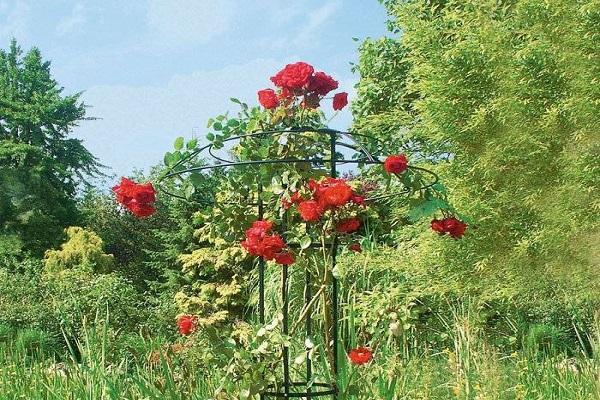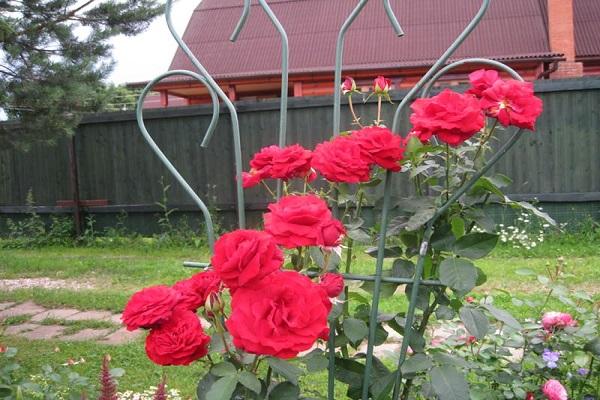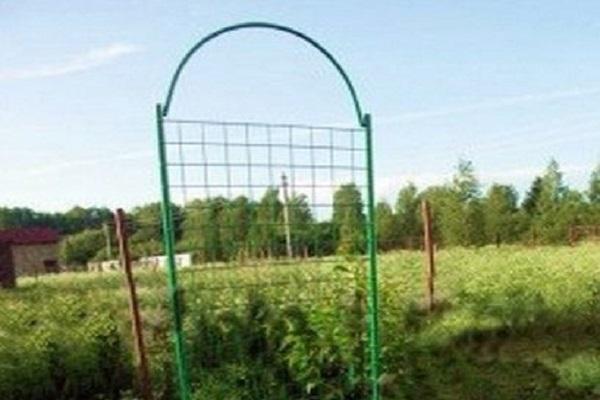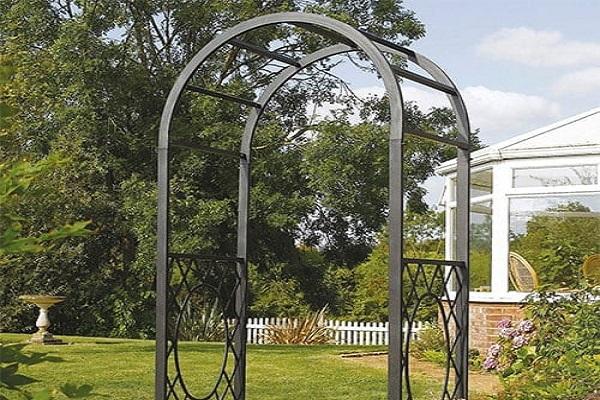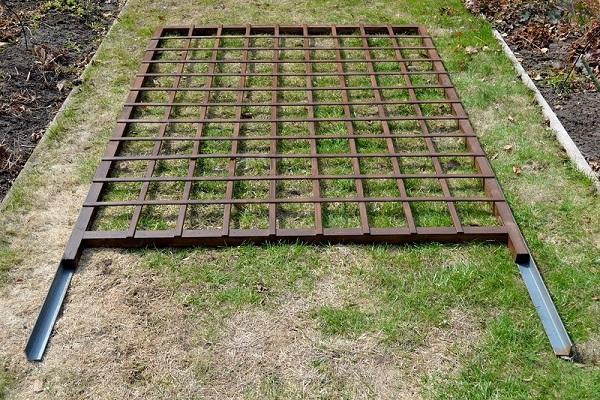Many gardeners prefer to plant spectacular climbing roses. However, in order for the plant to look beautiful, develop properly, and bloom profusely, its shoots must be supported on a solid basis. There are several types of supports for climbing roses; a suitable product can be bought in a store, or you can make it yourself from inexpensive materials.
What are they for?
Rose shoots do not climb without a supporting structure.The support allows you to correctly direct the shoots, form a beautiful bush, and create an interesting landscape composition.
Climbing roses are a popular garden decoration option. However, in an improperly fixed plant, buds appear only in the upper part of the bush. The shoots are placed on a support so that they, for the most part, run horizontally. Then the appearance of buds on the bush will be uniform.
Inexperienced gardeners believe that climbing roses can be planted against a wall or fence so that the plant can cling to protrusions and uneven surfaces on its own. But the lack of high-quality support negatively affects the appearance of the plant and flowering.
Requirements for supports for roses
The quality of a support for climbing roses is determined by the following criteria:
- Strength, stability. Rose bushes are quite heavy when in full bloom. The supporting structure, including the horizontal bars hanging above the ground, must support the weight of the plant. Vertical elements must be well anchored to the ground.
- Aesthetics. The support can be made of simple materials, but this option is only suitable for a small private garden. High-quality decorative stands are used to decorate parks, botanical gardens, and luxurious garden plots. Also, when choosing a product, the varietal characteristics of the plant are taken into account. Small structures do not go well with large bushes, and large, bulky ones do not go well with small-grade roses.
- Compactness. The product should look harmonious in combination with a rose bush. The design looks unattractive if its elements are too noticeable against the background of a flowering plant.
- Economical. The cost of a finished high-quality product is quite high, so many gardeners prefer to make rose supports with their own hands.
When designing a site, it is important to determine what material the support will be made of. When choosing a finished product or material for self-production, they take into account the style and external features of the plot, the size of the roses, and their financial capabilities.
Stands for climbing roses are made mainly from:
- wood;
- plastic;
- metal;
- stone
These materials are used separately or combined in one product.
What types of supports should not be used for climbing roses?
Shoots of climbing rose bushes are difficult to attach to obelisks. This form is optimal for climbing plants with flexible stems.
There are no tendrils on the shoots of roses that can be used to secure themselves to a supporting surface. Therefore, home garden owners have to use hooks and pieces of wire to secure the shoots. As the rose grows and its branches stretch out, more and more clamps are used.
Fine mesh is also an unsuitable support option for climbing roses. The plant will not be able to climb independently through small cells, and it will be difficult for the owner to fix the shoots.
If you want to use a mesh, then only with large holes.
Varieties
There are 4 main types of supports for climbing rose bushes.
Pillar
The simplest design option, but it is not suitable for all varieties of climbing roses. The poles are made of durable materials and are well anchored in the ground. In a small garden plot it is enough to place one pole, but in a large area you can make a composition of several poles installed in a row.
Arch and pergola
Arched supports are not only comfortable and functional, but also look aesthetically pleasing.And if they are made of high-quality material, they can easily support the weight of climbing, lushly flowering bushes.
Often large gardens are decorated with arches placed in a row, forming a gallery. Bushes of the same or different varieties of roses climb around each element of the gallery. The combination is very beautiful climbing roses of one variety, but with buds of different shades.
A pergola is a type of arch. This is the name of a small platform under a lattice roof supported on supporting pillars. Most often, the pillars are made of metal and the roof is made of wood.
Arches and pergolas can not only perform a supporting function for climbing roses, but also be used to divide the garden into sectors and to shade individual areas.
Trellis
The simplest support that is easy to make yourself. Moreover, production does not require expensive materials or a lot of time.
The trellis looks like a mesh with large holes, most often made of planks. This design meets all the requirements for supports: it is compact, stable, economical, and looks good on a personal plot.
Cones (pyramids)
The design consists of pillars connected at the top. If such a stand is high, then there is a lot of space between the pillars. That is, rose shoots can not only curl along the pillars, but also intertwine inside the cone.
How to make supports with your own hands?
If you don’t have the money to buy an expensive store-bought rose support, you can make it yourself. The easiest to manufacture is the pyramidal design.
To make the support, take two wooden boards 6 m long and 2.5 cm thick. The tools used are a hacksaw and self-tapping screws.
Algorithm of actions:
- A meter of length is cut from each board.
- Meter sections are divided in half and set aside.
- Boards 5 m long are also cut in half.
- The blanks are divided lengthwise to create slats 4 cm wide.
- At the bottom of the pyramid, inserts are made from 0.5 m boards.
- They are brought together at the top. The sides are reinforced with slats.
- Thin slats are used as horizontal steps between the pillars of the pyramid.
Tips from a landscape designer
To improve your garden plot and create a truly beautiful composition of climbing roses, it doesn’t hurt to follow the recommendations of experienced landscape designers:
- It is advisable to make cross bars on poles only if the plant has a lot of branches.
- Large, massive supports are combined with bushes that produce large buds. And narrow, vertically oriented products are more suitable for varieties with small flowers.
- The support should be installed before the bush is planted. If you do the opposite, the installed structure will injure the roots of the plant.
- The shoots will curl in a chaotic manner if they are not directed. Therefore, the owner must constantly shape the bush and secure the branches in the right places.
- Withered flowers are cut off to encourage new buds to form.
- If roses are planted along a fence or wall, then the supporting surface is coated with paint or varnish. This will prevent possible infection of the shoots.
Experienced gardeners advise regularly pruning roses and applying mineral fertilizer. Without these procedures, it will not be possible to form beautiful, lushly flowering bushes.

